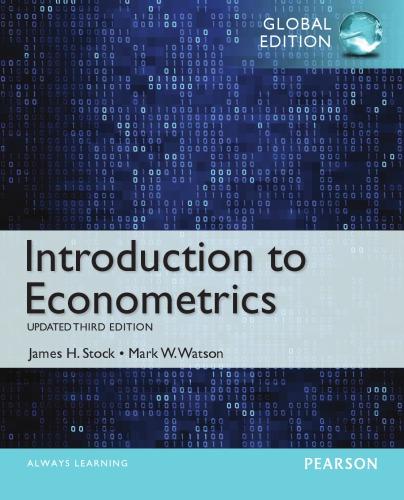E11.1 In April 2008 the unemployment rate in the United States stood at 5.0%. By April 2009
Question:
E11.1 In April 2008 the unemployment rate in the United States stood at 5.0%.
By April 2009 it had increased to 9.0%, and it had increased further, to 10.0%, by October 2009. Were some groups of workers more likely to lose their jobs than others during the Great Recession? For example, were young workers more likely to lose their jobs than middle-aged workers?
What about workers with a college degree versus those without a degree, or women versus men? On the textbook website, www.pearsonglobaleditions
.com/Stock_Watson, you will find the data file Employment_08_09, which contains a random sample of 5440 workers who were surveyed in April 2008 and reported that they were employed full time. A detailed description is given in Employment_08_09_Description, available on the website.
These workers were surveyed one year later, in April 2009, and asked about their employment status (employed, unemployed, or out of the labor force). The data set also includes various demographic measures for each individual. Use these data to answer the following questions.
a. What fraction of workers in the sample were employed in April 2009? Use your answer to compute a 95% confidence interval for the probability that a worker was employed in April 2009, conditional on being employed in April 2008.
b. Regress Employed on Age and Age2, using a linear probability model.
i. Based on this regression, was age a statistically significant determinant of employment in April 2009?
ii. Is there evidence of a nonlinear effect of age on the probability of being employed?
iii. Compute the predicted probability of employment for a 20-yearold worker, a 40-year-old worker, and a 60-year-old worker.
c. Repeat
(b) using a probit regression.
d. Repeat
(b) using a logit regression.
e. Are there important differences in your answers to (b)–(d)? Explain.
f. The data set includes variables measuring the workers’ educational attainment, sex, race, marital status, region of the country, and weekly earnings in April 2008.
i. Construct a table like Table 11.2 to investigate whether the conclusions on the effect of age on employment from (b)–
(d) are affected by omitted variable bias.
ii. Use the regressions in your table to discuss the characteristics of workers who were hurt most by the Great Recession.
g. The results in (a)–
(f) were based on the probability of employment.
Workers who are not employed can either be (i) unemployed or (ii) out the labor force. Do the conclusions you reached in (a)–
(f) also hold for workers who became unemployed? (Hint: Use the binary variable Unemployed instead of Employed.)
h. These results have covered employment transitions during the Great Recession, but what about transitions during normal times? On the textbook website, you will find the data file Employment_06_07, which measures the same variables but for the years 2006–2007. Analyze these data and comment on the differences in employment transitions during recessions and normal times.
Step by Step Answer:

Introduction To Econometrics
ISBN: 9781292071367
3rd Global Edition
Authors: James Stock, Mark Watson






